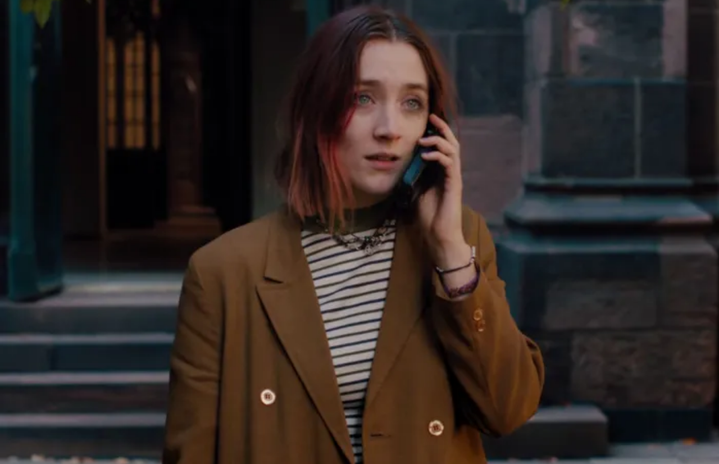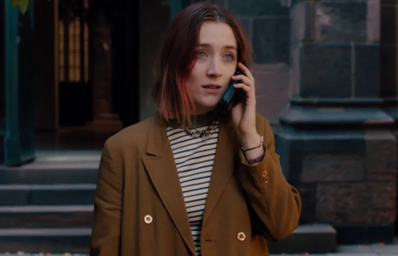If you haven’t seen Lady Bird you need to put it on your watch list. It’s my favorite coming-of-age story and an absolute comfort every time I rewatch it. The movie depicts the protagonist, Lady Bird, in her last year of high school as she navigates leaving for college, a complicated love life, friendship, and the fear of not being accepted. For anyone familiar with any of these classic young adult struggles, this might be the movie for you. Plus, Saoirse Ronan makes a perfect lead and the soundtrack is pretty awesome.
Lady Bird’s Search for love, approval, and individuality
If there’s one thing about Lady Bird, she is, in the most endearing way possible, weird. She changes her name from Christine to “Lady Bird,” dyes her hair hot pink, and has a quirky 2000s fashion sense that I envy. She’s also incredibly outspoken, especially when it comes to politics and social issues in her seemingly conservative school. While she honors her quirks and individuality, she acts out of character to impress her peers, so much so that she ditches her best friend, Julie, at their senior prom to go with a boy named Kyle (played by Timothée Chalamet) and his friends. Not that I’ve ever done anything like that, but I have sought out the approval of those around me, especially when I was in high school. A huge part of her search for approval comes from another goal of hers: to be loved. In the movie, you watch her navigate two romantic relationships, both of which come with major twists and turns. Her giddy, hopeless romantic attitude, teenage heartbreak, and pursuit to be loved make the movie extremely relatable to me as I reflect on my younger self.
Shame and money troubles
Unlike the other students at her Catholic private school, Lady Bird’s family struggles with money. This is just one of the ways she stands out as a bit of an “oddball” at her prestigious school. The protagonist feels a large amount of shame about how she differs from her peers and does just about anything in her power to keep her life at home a secret. Because Lady Bird worries so deeply about what people think of her, she lies to her classmates, telling them that a big, beautiful, blue house (Lady Bird’s favorite house) in the neighborhood belongs to her family. This blows up in her face when one of her new friends shows up at her “house,” and sees that Lady Bird is lying. In several instances throughout the movie, Lady Bird is confronted face-to-face with her own shame. With those she is close with, she often jokes that she is from the “wrong side of the tracks,” a reference to her neighborhood that is not nearly as nice as her classmates’ homes.
Lady Bird’s Complicated relationships with her mother
With her “good cop” dad and “bad cop” mom, Lady Bird gives us all the emotional whiplash of complicated relationships with parents. Lady Bird struggles to feel supported by her mother, whose work-related stress makes her too preoccupied to be a loving, available figure to her children. The two of them swivel between arguments and an endearing, loving connection. The movie shows several scenes of excessive bickering, emotional unavailability, and, again, Lady Bird’s pursuit for approval — this time from her mother. I’m always brought to tears by the highs and lows of their mother-daughter relationship. Truly, the dynamic between these two characters is so layered and well done. It gave me a reason to reflect on my own relationship with my mother (who is my total best friend). Despite her lash-outs and passive aggressiveness, I find myself sympathizing with Lady Bird’s mother as she navigates the pressure and expectations of motherhood.
Female Friendships
Lady Bird and her best friend, Julie, are vastly different. Julie is soft-spoken and has a real “just smile and nod” attitude. Regardless of their differences, the two girls are inseparable, and their relationship is infiltrated by inside jokes, cuddles, and support. Though their friendship faces conflict throughout the movie, I think Lady Bird does an amazing job of depicting the importance of female friendships, especially through those formative years of high school. This movie almost acts as a reminder to show gratitude to your own best friends, which is something Lady Bird does not always show to Julie. In the movie, you truly experience Lady Bird’s regret for mistreating her best friend and are delighted when they are able to reconnect. I think this movie is a great opportunity to reflect on your own female friendships; I guarantee seeing Lady Bird and Julie, in one way or another, will remind you of your own life.
Leaving For College
Lady Bird claims to hate Sacramento, the city she’s lived in her entire life. She constantly emphasizes the boringness she feels in her hometown and says in one scene, “I hate California, I want to go to the East Coast. I want to go where culture is… like, New York, or Connecticut or New Hampshire. Where writers live in the woods”. Interestingly enough, like many of us, she feels a deep appreciation for Sacramento after she leaves for college. When she’s visiting from, you guessed it, the East Coast, she takes a drive through her hometown and is overcome with nostalgia, sentiment, and emotion. As a college student, I find this experience immensely relatable. I never claimed to hate my hometown the way Lady Bird does, however, I absolutely gained a new appreciation for my charming Connecticut hometown once I left it.
Conclusion
This movie is a beautiful representation of the transition from an impressionable teenager to a young adult. Lady Bird brings you along for so many emotional, relatable experiences in just 90 minutes, and I truly believe every young woman could find themself relating to her in one way or another.



